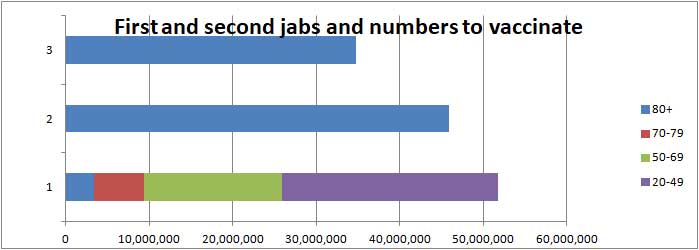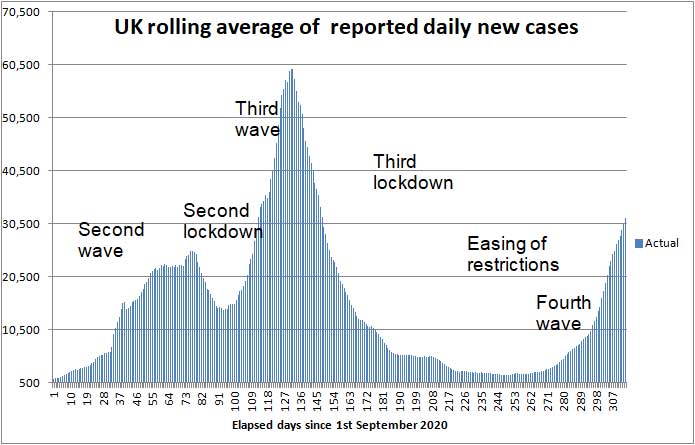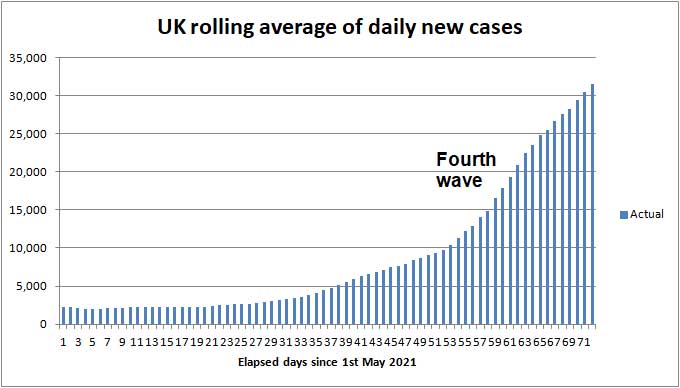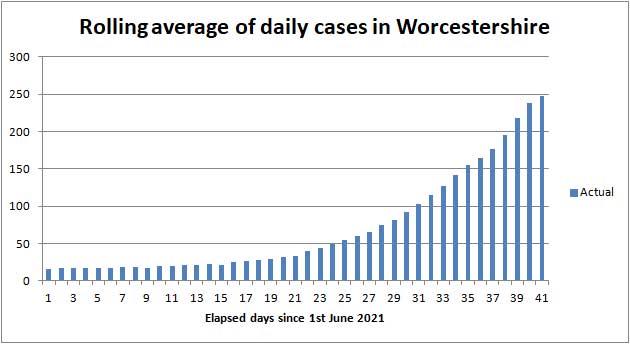
Angus and Rosemary's Miscellany
of Malvern - Other Resources
|
Coronavirus (COVID-19) epidemic weekly update for Malvern Seniors11th July 2021 COVID LOCKDOWN in ENGLAND EXIT MOVED TO 19TH JULY Cases rising sharply in the Malvern Hills district Skip to menu of archived pages PreambleWe keep an eye on the published government figures and monitor the media to asses the level of risk for Seniors in the Malvern Hills district. This page is normally updated every Sunday between 1800 and 2400 hours GMT. Information about Coronavirus can be found on the NHS website: https://www.nhs.uk/coronavirus
|
| Districts of Worcs | Cases | Weekly increase | Population |
| Bromsgrove | 7,124 | +387 | 98,529 |
| Malvern Hills | 3,223 | +157 | 77,545 |
| Redditch | 6,739 | +199 | 85,317 |
| Worcester | 7,074 | +443 | 103,542 |
| Wychavon | 7,033 | +270 | 126,240 |
| Wyre Forest | 6,162 | +273 | 100,957 |
| TOTAL | 37,355 | +1,729 | 592,130 |
| COMPARE WITH | |||
| County of Hereford | 7,809 | +222 | 195,000 |
| Leicester (city of) | 40,818 | +918 | 400,000 |
Cumulative cases reported by PHE in Worcestershire to 11th July 2021
The weekly increase is indicative; the seven day average by area, which varies day to day, is an alternative metric that can be found on the Coronavirus dashboard.
Bromsgrove and the City of Worcester are now COVID hotspots.
Daily cases in Herefordshire (per head of population) are one third of those in Worcestershire.
Interactive map
At the bottom of the Coronavirus Dashboard (daily update) page there is an Interactive Map which is coloured to show the variation in infection rate across the country. The map shows that infection rates are continuing to rise across the UK.
Click for Interactive Map of COVID cases
Note: the Interactive Map works on desktop PCs but it's possible you may encounter difficulties using a tablet or smartphone.
Ripples of the fourth wave are spreading into Worcestershire. Recent weekly cases to 6th July are: North Malvern 13; Malvern Link 10; Pickersleigh 13; Barnards Green 12; Malvern Wells and Priory 15; Callow End and Hanley 11; Upton and Welland 15.
Number of deaths
Statistics on COVID deaths are published by Public Health England, The Office of National Statistics, and NHS England.
PHE figures
Public Health England reports that the cumulative total of COVID (28) deaths in UK hospitals and care homes has risen by 203 in the last week to 128,425 while the daily average has increased from 17 to 29 deaths per day.
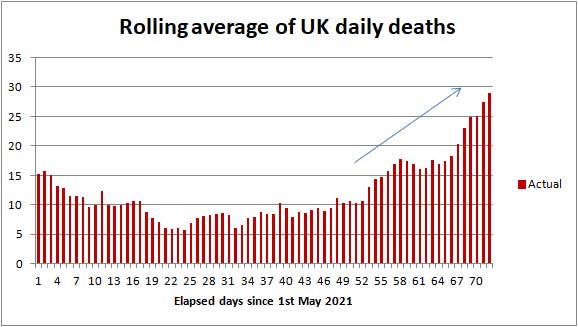
COVID-19 death rate 1st May to 11th July 2021
Click to view the UK government Coronavirus Dashboard
On average, the daily rate is increasing by one every day.
In comparison averaged over recent years 1,700 people die daily from all causes.
ONS figures
The Office of National Statistics (ONS) separately reports registered deaths in England and Wales where COVID-19 is mentioned on the death certificate. The ONS figures lag the PHE figures by 10 - 14 days and do not include Northern Ireland and Scotland.
Click for national ONS data on deaths (Excel spreadsheet)
The ONS figures are broken down by District providing a glimpse of where deaths are occurring. The provisional cumulative total of COVID related deaths in Worcestershire reported by the ONS up to 25th June 2021 (week 25 of 2021) is shown below.
Note: the numbers are from the ONS Death Registrations-Pivot table
| Districts of Worcs | Deaths 2020 |
Deaths 2021 |
Week 25 | Population |
| Bromsgrove | 164 | 101 | 0 | 98,529 |
| Malvern Hills | 61 | 83 | 0 | 77,545 |
| Redditch | 108 | 85 | 0 | 85,317 |
| Worcester | 87 | 116 | 0 | 103,542 |
| Wychavon | 157 | 119 | 0 | 126,240 |
| Wyre Forest | 171 | 106 | 0 | 100,957 |
| TOTAL | 748 | 610 | 0 | 592,130 |
Provisional cumulative COVID-19 deaths registered by ONS to 25th June 2021
Once again no COVID deaths were recorded in Worcestershire.
So far in England and Wales 98 COVID-19 related deaths have been reported by the ONS in the week to 25th June; 4 less than last week. Of these 8 were in a care home, 18 at home, 1 in a hospice, 70 in hospital and 1 elsewhere.
Note: summation of rows 9 to 339 of the ONS deaths Registrations-Pivot table.
The provisional UK COVID-19 death toll (as reported by PHE and ONS) for all weeks of the epidemic can be found on the Deaths tab of the Coronavirus Dashboard.
NHS England figures
The table below shows latest COVID deaths in Worcestershire hospitals reported by NHS England to 9th July.
| Worcestershire | Cumulative deaths | Past week |
| Acute hospitals | 808 | 0 |
| Care hospitals | 63 | 0 |
| TOTAL | 871 | 0 |
Click for NHS COVID-19 Daily Deaths
Risk of COVID-19 death by age band
NHS England provides an analysis of COVID-19 deaths in hospital in England and Wales by age band. Shown below is a breakdown of recent deaths for the period 1st June 2021 to 8th July 2021 when the death rate averaged 10 deaths per day.
| Age band | Number of deaths | % of deaths |
| 0 - 19 | 5 | 1 |
| 20 - 39 | 17 | 5 |
| 40 - 59 | 66 | 18 |
| 60 - 79 | 135 | 37 |
| 80+ | 144 | 39 |
Risk of COVID-19 death by age band
Those aged 60+ years still account for 76% of deaths compared to 92% last year, but remember the death rate as a proportion of new cases is much lower than in 2020.
Most fatalities are said to have had a pre-existing condition.
Healthcare numbers
The UK government Coronavirus Dashboard includes important information about healthcare statistics.
| Hospital COVID cases (UK) | Number | Change since last week |
| Patients currently in hospital | 2,731 | +826 |
| Patients on ventilation | 417 | +117 |
| Patients admitted daily | 563 | +205 |
Headline summary of patients in hospital as reported 11th July 2021
The daily number of hospital admissions expressed as a 7 day average fell to 100 about 20th May but has crept up to 563 and might be expected to increase further in proportion to the rise in daily cases. If roughly 2,000 new cases per day in May led to 100 daily admissions, then the current (average) 30,000 or so cases per day could see daily admissions rising towards 1,500.
In the past, the steady state number of COVID patients in hospital has been roughly ten time the number of patients admitted daily, so we could see the number of COVID patients in hospital rising towards 15,000 in August, which would be a significant burden on the NHS.
Last week we assumed that due to vaccination 1 in 12 of those admitted to hospital now dies (whereas last year it was 1 in 5). If we relate the latest average of 17 deaths per day to hospital admissions two weeks ago the figure might be nearer 1 in 13, in which case the present 563 hospital admissions per day could point to a COVID daily death rate of about 45 by the end of July.
Tabulated figures for bed occupancy in Worcestershire Acute and Care hospitals can be found on the NHS England website.
Click for NHS England COVID-19 Hospital bed Activity
An easy to read summary can be found on the Worcestershire Coronavirus Dashboard.
Click to view Worcestershire Coronavirus Dashboard.
Recently there have been 8 COVID-19 patients occupying Worcestershire Acute Hospital beds, of which 1 is a ventilated bed; an increase of 2 on last week.
Note: it's possible as hospitals fill in Birmingham, where there are many more cases, part of the overflow could be sent to acute hospitals in Worcestershire distorting local figures.
The main point to note is that the number of Worcestershire COVID-19 beds occupied is much lower than the peak of about 300 beds.
Forecast for the week ahead
Trends suggest that during the next seven days (up to 18th July) the cumulative total of new UK COVID-19 cases reported by PHE on the Coronavirus Dashboard could increase by 230,000 towards 5,355,000.
In Worcestershire more than 2,000 new cases of COVID-19 can be expected, and possibly 200 cases in the Malvern Hills district.
We estimate the number of COVID (28) deaths will increase by about 250 nationally towards 128,675 during the 7 days ending 18th July 2021.
In the county of Worcestershire, assuming a 0.3% death rate, the 1,729 new cases this week should translate to no more than 5 COVID deaths per week towards the end of July.
Longer term forecast
When the Alpha (Kent) variant was predominant commentators suggested that the UK could be approaching herd immunity due to both the success of the vaccination programme, and immunity of those who had already been infected by COVID-19. The flare up of cases across the UK caused by the more transmissible Delta variant indicates a higher level of vaccination such as 85% will be needed to counter the Delta Reproduction Rate estimated 6 to 7, and we are not there yet as only 54% of the population has been fully vaccinated so far.
The next chart shows the rolling average of daily cases in red and an exponential curve fitted to June data in blue. This was suggesting that daily cases could have risen to 70,000 by the 11th July Surprisingly in the last 10 days the rolling average shows signs of possibly approaching a plateau, of about 34,000 cases per day. However were the present slope to be maintained, and the curve not turn over, the rolling 7 day average of daily new cases could alternatively approach 40,000 new cases per day by 19th July when restrictions are to be lifted in England.
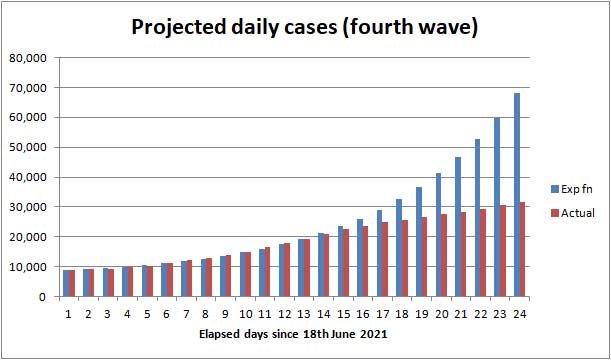
Chart showing cases are not rising exponentially at present
Households mingling at home and groups meeting inside and outside pubs to watch the Euro football matches will have helped push up the numbers.
Once the government lifts restrictions, and families travel on summer holidays, more pockets of infection are likely to flare up as the virus moves across the country seeking out the frail and unvaccinated. The government seems fairly sure that this time the NHS won't be overwhelmed by COVID, although Sajid Javid acknowledges 'bed blocking' by COVID patients could seriously extend waiting lists.
Scientists are saying the size and duration of the expected increase in cases during August cannot be predicted with any certainty and will partly depend on vaccine uptake and how cautious people are.
So far the COVID death rate during the 'fourth wave' has remained low and our guess is that it won't rise much above 100 before falling back in the autumn, as the percentage of the population vaccinated rises, and survivors develop immunity.
A ripple of cases amongst unvaccinated children and teenagers cannot be ruled out - either in August or when pupils go back to school in September.
We'll just have to wait and see how things pan out in coming weeks and adjust our behaviour accordingly.
Advice for Seniors
 Due
to vaccination the death rate this summer is broadly a factor of 15 times
lower than last year. However the daily number of new cases of
Coronavirus in the Malvern Hills district has been rising sharply, and 76% of deaths are still amongst those aged 60+ years, despite
most Seniors having had 2 jabs. We therefore judge the
risk of death from COVID-19 for
vaccinated Seniors to be
in the range
LOW for the healthy to MODERATE
for the frail;
see our annex and riskometer opposite.
Due
to vaccination the death rate this summer is broadly a factor of 15 times
lower than last year. However the daily number of new cases of
Coronavirus in the Malvern Hills district has been rising sharply, and 76% of deaths are still amongst those aged 60+ years, despite
most Seniors having had 2 jabs. We therefore judge the
risk of death from COVID-19 for
vaccinated Seniors to be
in the range
LOW for the healthy to MODERATE
for the frail;
see our annex and riskometer opposite.
Remember, if you are elderly, have not been vaccinated, and were to catch COVID there is a significant chance that you will either die or your long term health may be seriously damaged, so if you are able get both doses of your vaccine and continue to take care of yourself and those you love. Encourage your children and grand children to be vaccinated.
Click for our risk of death table (for those who have not been vaccinated)
It seems possible, despite a second jab, for Seniors to become ill with COVID-19; some might have mild symptoms like hay fever, while others could feel very poorly, but few except the frail will need to be admitted to hospital.
The simple safeguards to remember are to:
-
wash your HANDS thoroughly, using soap and hot water, for 20 seconds, including after handling deliveries to your home, to kill virus picked up from contaminated surfaces see note 1;
-
wear a FACE covering when unavoidably near other people for example when shopping, visiting hospital or the chemist, and using public transport;
-
SPACE at least 2 metres from people you don't feel safe with see note 2;
-
preferably meet friends and other households outdoors in the FRESH AIR, else, if you can, keep doors and windows open if you are indoors;
-
minimise TIME near strangers;
-
self-isolate and book a test if you have COVID-19 symptoms (the top five symptoms amongst the vaccinated are now said to be headache, runny nose, sore throat, sneezing and persistent cough).
-
keep away from crowded indoor settings and areas where the infection rate is known to be high.
Notes:
1) Wash your hands thoroughly before touching your face to avoid transferring virus from contaminated surfaces to your mouth, eyes and nose. If outdoors use hand gel.
2) Two metres is further than you think - roughly an arm and a walking stick away.
Annex to 11th July update
Commentary
Much to report during the last week in which the PM stated his intention to end the lockdown on 19th July despite cases rising sharply in the UK. There is an emerging view amongst both MPs and scientists that now the most vulnerable have been vaccinated we must get used to living with COVID before the winter sets in when more time is spent indoors.
On Monday the PM announced that England would very likely move to STEP 4 of the Road Map out of lockdown on 19th July when most legal COVID restrictions would be lifted. Expect a briefing from the PM on 12th July.
Click to read PM statement at coronavirus press conference: 5 July 2021
It will then be our personal responsibility to decide what precautions should be taken to protect against COVID, for example the wearing of face masks and social distancing.
A target is for all those aged 18+ years to be offered a vaccine by the 19th July and for two thirds of adults to be offered two doses. Finally for all adults to be offered two jabs by mid-September.
The PM spoke about a five point plan to keep the country safe, the chief measures being:-
-
First, to reduce the dose interval for under 40s from 12 weeks to 8, so that everyone over 18, who wants to be, should be double jabbed by mid-September, plus Autumn booster vaccines for the most vulnerable.
-
Second, to move away from legal restrictions and allow people to make their own informed decisions about how to manage the virus. From Step 4, all legal limits on the numbers meeting indoors and outdoors will be removed. Businesses to re-open, including nightclubs. Limit lifted on named visitors to care homes, and on numbers of people attending concerts, theatre, and sports events. No '1 metre plus' rule on social distancing, no legal obligation to wear a face covering, although guidance will suggest where you might choose to do so, especially when cases are rising, and where you come into contact with people you don’t normally meet in enclosed places, such as obviously crowded public transport. No need to work from home, so employers will be able to start planning a safe return to the workplace. There will be no Covid certificate required as a condition of entry to any venue or event, although businesses and events can make use of certification - the NHS app gives people a Covid pass as one way to show Covid status.
-
Third, continuation of test, trace and isolate system. You will have to self-isolate if you test positive or are told to do so by NHS Test and Trace. But there will be a different regime for fully vaccinated contacts of those testing positive, and also for children. Education Secretary to make a statement (see below).
-
Fourth, tough border controls will be maintained – but recognising the protection afforded by two doses of vaccine the need for fully vaccinated arrivals to isolate on return from an amber country will be removed. Transport Secretary to make a statement (see below).
-
Fifth, Health Secretary to continue to monitor the data and prepare contingency plans to help manage the virus during the winter.
In answer to questions it seems the government is waiting for more safety evidence from other countries before deciding whether or not to vaccinate those aged 12+ years, and is unsure exactly how fast hospital admissions and deaths might rise after controls are lifted on 19th July.
The SPI-M modelling group had provided projections dated 9th June of what might happen if the country were to move to STEP 4 on 21st June.
See summary of further modelling of easing restrictions – Roadmap Step 4
Our reading of these suggests cases could have risen to 250,000 per day by mid August. In consequence hospital admissions could have risen to 2,500 per day; COVID hospital beds could have risen to 20,000 and deaths could have risen to 300 per day. Projected cases followed a bell shaped curve of broadly 6 to 8 weeks duration.
We assume SPI-M is producing a new analysis for unlocking on 19th July when more people will have been vaccinated and the projected number of cases could be fewer. However modellers say the projections are very sensitive to the assumptions so the outcome is in any event very uncertain.
Health Secretary Sajid Javid has suggested daily new cases might reach 50,000 by 19th July and could peak at about 100,000.
On Tuesday the Education Secretary Gavin Williamson told MPs that:
-
From 19 July face coverings will no longer be needed and social distancing will no longer be necessary in schools.
-
The system of bubbles - where children only mix within a fixed year or class group - will come to an end.
-
The NHS Test and Trace system will take responsibility for contact tracing for nurseries, schools and colleges.
-
From 16 August, unvaccinated under-18s will only have to self-isolate if they test positive for Covid.
-
A pupil who has been in close contact with someone with Covid need not quarantine but would be advised to take a PCR test instead.
Click for BBC report on the rules for schools changing
The emphasis is moving from isolating to frequent testing.
On Wednesday the Health Secretary Sajid Javid made a statement to MPs about moving to STEP 4. Little new was announced.
Click for update on the pandemic and the roadmap to freedom
The German government announced that the ban on travellers from the UK would be lifted. Visitors who are fully vaccinated will not be required to quarantine. Non-vaccinated travellers would still be required to quarantine for up to 10 days, with the option to end their quarantine early with a negative test on the fifth day.
Click to read BBC report - Germany lifts ban on tourists from UK and Portugal
On Thursday the Transport Secretary Grant Chapps announced from 19th July those arriving back in England from Amber list countries won't have to quarantine if they have been fully vaccinated; but they would have to pass a COVID test before returning to the UK and take another test within 2 days of their arrival, at their own expense.
Click to read - International travel from amber list countries and territories
Reciprocal arrangements for fully vaccinated tourists are still being worked up.
There are rumours that 16 and 17 year old unpaid carers can get the vaccine through their GP surgery.
A COVID state of emergency was announced in Tokyo. No visitors would be allowed at the Olympic Games.
On Friday Border Force warned of possibly delays at airports due to the need to check COVID related paperwork.
Concern was expressed at the high number of people being pinged by Test and Trace as new cases escalate; you might not be aware there could be a £1,000 fine for those who refuse to quarantine.
In a press release dated 6th July Sajid Javid says as part of STEP 4 fully vaccinated individuals won't have to isolate after 16th August.
Click for statement: self-isolation to be eased for fully vaccinated adults
Meanwhile Grant Chapps has suggested the NHS app might be tuned to make it less sensitive:
Click for BBC report: NHS Covid app may change as rules change
Meanwhile some individuals are taking matters into their own hands by either turning off their phones or removing the app.
On Sunday Susanna Reid of ITV Good Morning Britain, Professor Sir David Spiegelhalter of Cambridge University and Vaccines Minister Nadhim Zahawi appeared on the Andrew Marr show.
Susanna Reid said only half of men aged between 18 and 24 years had been vaccinated. An incentive was being able to go on holidays abroad, and return from Amber list countries without having to quarantine.
It was rumoured that the gap between first and second jabs might be reduced to 4 weeks.
David Spiegelhalter gave some insight on the protection offered by the vaccines.
The unvaccinated elderly are at high risk of dying from COVID-19.
Vaccines offer (the elderly) a factor of 20 protection from dying of COVID-19. Unvaccinated individuals aged under 30 were at even lower risk.
Most of those currently dying rom COVID-19 are vaccinated individuals aged over 50 years, not the unvaccinated under 50 years.
Vaccination reduces cases of COVID-19 in those aged over 65 by a factor of 4.
The average age of those being infected is now 25 years; those individuals are unlikely to die, but there is evidence up to 1 in 6 may suffer from Long COVID with symptoms persisting for more than 3 months.
Hospital admissions were 1 in 10 of cases last year but are now about 1 in 40 so if cases were to rise to 100,000 per day, hospital admissions could rise to 2,500 per day. However the time spent in hospital might be less than last year.
Vaccines' Minister Nadhim Zahawi agreed with Andrew Marr that vaccination rates had fallen steeply in the last month, but said this was due to lack of demand, not shortage of vaccines.
He said of the 2,300 COVID patients in hospital last Friday:-
62% were aged under 55 years, compared to the majority being over 65 years last year.
15% were aged over 75 years - which was being closely monitored.
Other updates
Click to watch Tim Spector's weekly Zoe COVID update on YouTube
The first nine minutes of the weekly Independent SAGE briefing on mental health is worth looking at if you are interested in charts and how the numbers are changing:-
Click to watch Independent SAGE 9th July briefing
Overseas travel
The UK and other nations are debating reciprocal arrangements for vaccinated travellers but much of the summer may have gone before this is widely agreed.
It is now possible to get an NHS Vaccination Pass for overseas travel, which will require you to prove your identity for example by providing a photo of your passport; this should facilitate return from Amber list countries.
Click for information about the NHS COVID Pass
See BBC report - EU vaccine 'passport' and what it means for travel
List of vaccines
Here is the list of vaccines ordered by the UK - a shortage of vaccine had been limiting the vaccination rate in the UK earlier in the year, but possibly not now. Plenty of vaccine is on order for delivery later in the year some of which may be needed for booster jabs and vaccinating those aged under 18 years.
| COVID-19 vaccine | Doses ordered (million) | Status |
| Pfizer BioNTech, two dose, -70 deg C | 40+60 | Approved, deliveries continuing, made in Belgium (EU). An additional 60M doses have been ordered for booster shots for the most vulnerable in the autumn. |
| Astrazeneca, two dose, fridge | 100 | Approved for those aged 30+ years; deliveries continuing. Batches made in UK, Belgium and India. |
| Moderna, two dose, -20 deg C | 7+10 | Approved. First deliveries to Wales and Scotland 7th April 2021 then England 13th April; mainly for those aged under 50 years awaiting vaccination. |
| Valneva, two dose | 60+40 | A jab from French company Valneva will be made in Livingston, West Lothian, Scotland. Delivery to start in second half of 2021. |
| Janssen, single dose | 20 | Approved, a jab from Belgian firm Janssen, owned by Johnson and Johnson; UK approval 28th May. Order reduced from 30 to 20M. |
| Novavax | 60 | A jab manufactured by US firm Novavax is being made in Stockton-on-Tees UK; phase III trials complete, awaiting approval. Should be available later this year. Glaxo Smith Kline (GSK) has been contracted to fill and package vials. |
| GSK Sanoft | 60 | Some delay due to adjusting the formula to give better protection to the elderly; possible availability late 2021. |
| Curevac | 50 | Contract placed with German company Feb 2021. Possible source of new variant vaccine later in 2021 |
Table of vaccines ordered by the UK government
Present rate of new cases and risk
The hotspots in England and Scotland are expanding across the whole of the UK and the general infection rate is now very high; were it not for the vaccines the death rate would be heading towards 500 deaths per day.
The average rate of infection per 100,000 population per week in England has risen from 208 to 301 while in comparison the figure for Worcestershire has risen to 236 and the Malvern Hills to 171.
As a yardstick we suggest a figure of below 10 can be considered LOW.
Areas of high infection still include Blackburn 370, Ribble Valley 408, Rossendale 636, Bolton 319, and Salford 520.
Other areas with many cases include Birmingham, Leeds, Liverpool, Wigan, Manchester, County Durham, Newcastle on Tyne, Dundee, Glasgow and Edinburgh
There is now a fair chance of catching COVID-19 within the Malvern Hills, but as most Seniors have been vaccinated with 2 jabs we judge the risk of death LOW for the healthy, and MODERATE for the 'frail'.
The risk of death from Coronavirus for unvaccinated children and healthy teenagers is said to be small so for them the risk is LOW. There is however emerging concern that one in six youngsters might suffer from Long COVID.
The middle aged can suffer from debilitating Long COVID so for those that have not been vaccinated the risk might be judged fairly HIGH.
About the final UK COVID-19 death toll (unchanged)
At the start of the epidemic on 17th March 2020 the Chief Scientific Adviser, Sir Patrick Valance, questioned by the Health Select Committee, did not disagree with Jeremy Hunt's suggestion that a death toll of 20,000 might be a reasonable outcome.
On the other hand, Professor Neil Ferguson of Imperial College warned in some scenarios the death toll might be as high as 250,000; while we thought, in the very worst case assuming up to 1% of the UK population died the outcome might have been nearer 400,000 taking into account some build up of herd immunity.
So how well will the UK have done? When Jeremy Hunt and Sir Patrick Valance spoke there had been few deaths and they clearly underestimated what was to come. Professor Neil Ferguson was nearer the mark. A few might consider an outcome of about 128,000 deaths a fair result compared to a greater number of people dying in a very short space of time, more being permanently disabled by Long COVID, temporary collapse of the NHS and patients dying at home or queued in ambulances outside hospitals. You have only to look at the recent situation in India to imagine what could have happened.
Members of the Labour Party and others will no doubt say the UK has done poorly compared to the best performing countries such as Australia, New Zealand and Singapore where deaths have been much lower, not to mention the enormous expense of supporting those out of work and huge damage to the economy.
With hindsight, deaths might have been much lower if the second lockdown had been continued into December and January, but that would have meant cancelling Christmas, and who knows to what extent the public would have complied.
Worldwide, this pandemic is not played out and it could be a further 1 to 2 years before the 'dust' finally settles. The PM has promised an independent inquiry in Spring 2022 to learn lessons for the future.
Summary of Links
Symptoms
Article about the effects of Coronavirus on the human body
Reporting and how to obtain a test
How to get a test
https://www.nhs.uk/coronavirus
About joining the Zoe COVID Symptom Study:
Guidance
UK government Coronavirus guidance
Tiers
Guidance on tiers: what you need to know
Government postcode checker to find tier for other areas
Statistics
UK government Coronavirus Dashboard
Coronavirus Dashboard Interactive Map
ONS data on deaths in England and Wales (Excel spreadsheet)
NHS England COVID-19 Daily Deaths
NHS England COVID-19 Hospital Admissions
NHS England vaccination statistics
Worcestershire Coronavirus Dashboard
Worcestershire COVID-19 Vaccinations Dashboard
A glimpse of the worldwide vaccination situation can be found on the Our World in Data website.
Click for chart showing % vaccinated
Modelling
A projection of the future COVID-19 death toll and daily deaths can be found on The Institute for Health Metrics and Evaluation website.
Click for IHME projection of COVID-19 deaths
Reports
ONS Coronavirus (COVID-19) Roundup
The bigger picture
Worldometer summary of coronavirus cases worldwide
European Centre for Disease Prevention and Control info
https://www.ecdc.europa.eu/en/geographical-distribution-2019-ncov-cases
World Health Organisation info
Window on the USA
Centre for Disease Control (CDC)
American Association of Retired People (AARP)
Worcestershire
Help:
http://www.worcestershire.gov.uk/here2help
Worcestershire County Council COVID-19 information:
http://www.worcestershire.gov.uk/coronavirus
Here you will find a useful link,
'Website: Number of new cases by date in Worcestershire'
which displays interesting COVID charts and statistics for Worcestershire
Miscellaneous
Spanish Flu
Dr Jeff Kildea's commentary about the 1919 outbreak of Spanish Flu in Australia
Views of Martin McKee, Professor of European Public Health
Follow Martin McKee on Twitter
SAGE membership
Scientific Advisory Group for Emergencies (SAGE)
Scottish government:
Link to Scottish Government website
Link to Postcode checker for COVID restrictions by protection level in areas of Scotland
Welsh Government:
Guidance on COVID alert levels in Wales

The interpretations and opinions expressed are our own
Last updated 13th July 2021
 Blogs
>
Blogs
>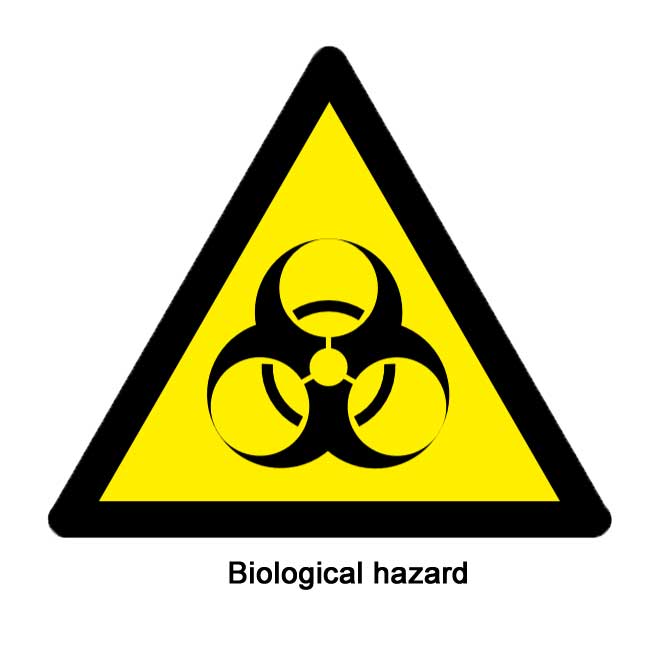 How
to request a COVID test
How
to request a COVID test Please
consider helping others by downloading the COVID Symptom Study app onto your
smart phone or Ipad and reporting how you feel either daily, or as you are
able. Note that currently there is no desktop PC version for Windows.
Please
consider helping others by downloading the COVID Symptom Study app onto your
smart phone or Ipad and reporting how you feel either daily, or as you are
able. Note that currently there is no desktop PC version for Windows.